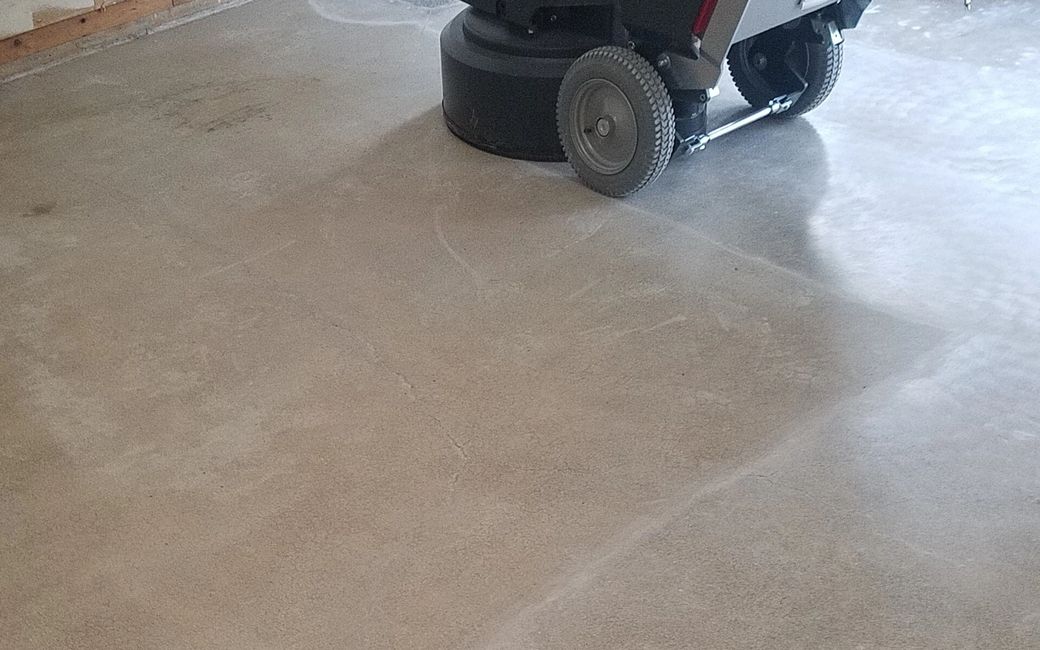Why concrete polishing?
Additional Information
There are a multitude of benefits of a polished concrete floors, not the least of which is the natural beauty of the product. The eye 'pop' of a polished floor is always at the top of the list.
- Polished concrete floors are Leed friendly.
- Concrete floors stay cooler in the summer, retain heat in the winter and therefore reduce energy costs.
- The high reflectivity (shine) of polished concrete floors requires less energy spent on lighting which equals reduced energy costs.
- Less chemicals in cleaning equals better for you, the environment and reduced costs overall.
- A polished concrete floor lasts longer than floor coverings. This reduces waste and raw materials needed to replace or cover the surface...again, and again.
- Polished concrete floors are just simply easier and less expensive to maintain. A neutral (ph balanced) cleaner and plain water work great.
- Sustainability and durability; words that actually mean something when discussing a polished concrete floor.
- They just plain look great.
The creation of a polished concrete floor starts with the concrete slab. Whether existing or new, it is important to understand the variations of each slab, which are so commonly referred to as imperfections. Concrete by design, is a product that is made with all of natures wonder and differences and then molded and transformed by men and machines. Every single slab is different..always. And to most, that is a major part of the beauty of the final product, the polished concrete floor.
Many variations occur in every slab. These include spalls, color, cracks or crazing, and texture. Grinding on the way to a polished slab will expose and magnify these items. Options exist to deal with these and become part of the design decision process. Existing, and sometimes new, concrete may be out of tolerance. Some slabs may be so deteriorated and aged that they will be unable to be used.
We use comprehensive polished concrete systems, installed using quality equipment and personnel.
Benefits of Polishing
- Long lasting and durable
- Low maintenance
- Variable levels of reflectivity and exposure
- Numerous color options
- A high quality and stunningly decorative floor

Pick your floor
Seattle Concrete Polishing delivers a quality product, which starts with insuring that the customers desires and needs are understood. Customers with knowledge of the process, options and choices guide polishing floor contractors means and methods for the project.
The American Society of Concrete Contractors (ASCC) has published a guide to assist owners with understanding and choosing what floor they want. This helps put both the contractor and the owner on the same page before the start, to insure a great finish.
There are 3 levels of grinding and 4 levels of polishing Stained concrete floors (or dyed) do not change the choices here.
First, pick your grind! Three classes here;
'A' Cement Fines 85-95% cement fines, 5-15% fine aggregate
'B' Fine Aggregate 85-95% fine aggregate, 5-15% blend of cement fines and course aggregate
'C' Coarse Aggregate 80-90% coarse aggregate, 10-20% blend of cement fines and fine aggregate.
Aggregate exposure class denotes the surface exposure after grinding and polishing operations. The density, size and distribution of the aggregates at the surface depends on the concrete mix design and placing and finishing operations. Floor flatness (FF) at the time of grinding and polishing operations is an important consideration in selecting the appropriate aggregate exposure class.
Surface exposure percentages are based on visual observation of the overall area of the polished floor.
Next, pick your polish! Four classes here;
Flat (Ground) Images of objects being reflected have a flat appearance. Image clarity value of 0-9%.
Satin (Honed) Images of objects being reflected have a matte appearance. Image clarity value of 10-39%.
Polished Images of objects being reflected do not have a sharp and crisp appearance but can be easily identified. Image clarity value of 40-69%.
Highly Polished Images of objects being reflected have a sharp and crisp appearance as would be seen in a near-mirror like reflection. May require grouting. Image clarity value of 70-100%.
The 4 levels listed above all share a Haze Index of <10, as noted below.
The fine print, from ASCC:
The reflectivity (often referred to as the 'shine') is measured by a term referred to as Distinctness-of-Image (DOI) Gloss. DOI is the sharpness of images of objects produced by reflection at a polished surface, sometimes called image clarity.
Measurement by Image Clarity Meter (ASTM D5767): The DOI, Image Clarity Value, obtained from this test method, range from 0-100 with a value of 100 representing perfect DOI (image clarity.
Haze is the cloudiness or milky appearance of images of objects produced by reflection in a polished surface. Measurement by Glossmeter (ASTM D4039): The Haze Index, obtained from this test method, is computed using the numeric difference between the value of specular gloss at 60 degrees and the value of specular gloss at 20 degrees.
Measurements for Compliance
The Image Clarity Meter and Glossmeter must be calibrated and used i accordance with ASTM D 5767 and ASTM D4039.
The minimum number of tests distributed across the polished surface should be three for areas up to 1000 sq ft and one additional area for each 1000 sq ft or fraction thereof. This applies to both the Image Clarity Value and Haze Index.
The mean (average) values of the test results should be used to evaluate compliance with this chart.
Much of the above information was taken from and/or quoted from ASCC.
Copyright © 2018 Seattle Concrete Polishing - All Rights Reserved.